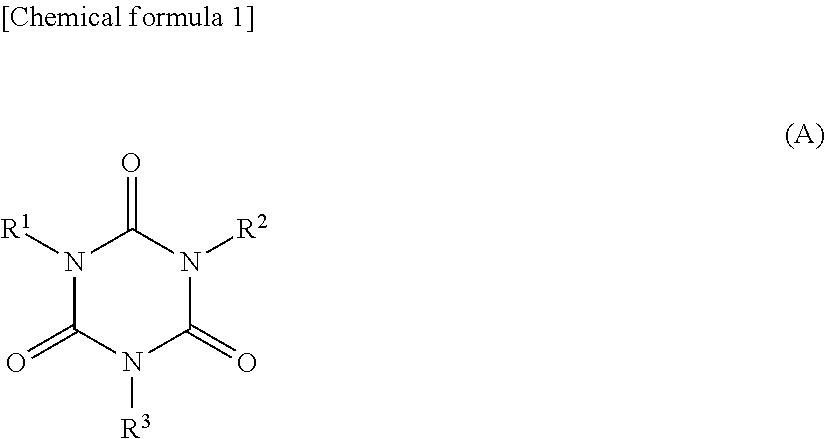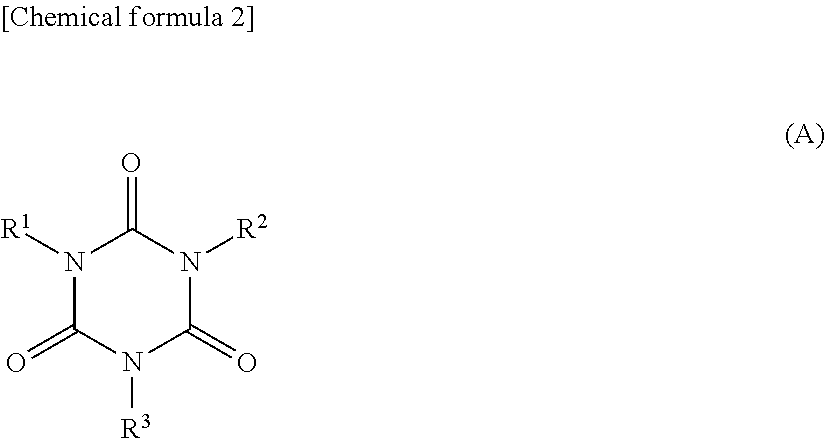Non-aqueous electrolytic solution and non-aqueous electrolyte secondary battery using the same
a technology of non-aqueous electrolyte and secondary battery, which is applied in the direction of electrolytes, cell components, organic electrolytes, etc., can solve the problems of difficult to achieve both high temperature lifetime and suppression of large current capacity deterioration, and achieve excellent general performance balance and large theoretical capacity. , the effect of excellent general performance balan
- Summary
- Abstract
- Description
- Claims
- Application Information
AI Technical Summary
Benefits of technology
Problems solved by technology
Method used
Image
Examples
examples 1-1-1 to 1-1-5
and Comparative Examples 1-1-1 to 1-1-3
[Production of Positive Electrode]
[0415]85% by mass of lithium-nickel-cobalt-manganese composite oxide (NMC) as a positive-electrode active material, 10% by mass of acetylene black as a conductive material and 5% by mass of polyvinylidene fluoride (PVdF) as a binder were mixed in a N-methylpyrrolidone solvent with a disperser to form a slurry. This was uniformly applied on both sides of an aluminum foil having a thickness of 21 μm, and the foil was dried and subsequently pressed to make a positive electrode.
[Production of Negative Electrode]
[0416]50 g of Si fine particles having an average particle diameter of 0.2 μm was dispersed in 2000 g of scaly graphite having an average particle diameter of 35 μm, and the dispersion was put into a hybridization system (manufactured by Nara Machinery Co., Ltd.) and treated by being circulated or stayed in the device at a rotor speed of 7000 rpm for 180 seconds to obtain a complex of Si and graphite particl...
examples 1-2-1 to 1-2-2
and Comparative Example 1-2-1
[Production of Positive Electrode]
[0424]A positive electrode was produced in the same manner as in Example 1-1.
[Production of Negative Electrode]
[0425]In addition to the negative electrode active material produced in Example 1-1, negative electrode active materials 1-1 to 1-3 having various Si contents shown in Table 1-2 were produced in the same manner. The negative electrode active material 1-1 is the active material itself used in Example 1-1. The Si content is the mass concentration (% by mass) of the Si fine particles with respect to the total of Si fine particles and graphite particles (100% by mass).
TABLE 1-2SiAverage particleTapSpecific surfacecontentdiameter (d50)densityareawt %μmg / cm3m2 / gNegative2.0201.07.2electrode activematerial 1-1Negative12.0171.16.3electrode activematerial 1-2Negative17.0201.18.1electrode activematerial 1-3
[0426]To the negative-electrode active material were added an aqueous dispersion of carboxymethylcellulose sodium (the...
examples 1-4-1 to 1-4-3
and Comparative Example 1-4-1
[Production of Positive Electrode]
[0443]A positive electrode was produced in the same manner as in Example 1-1.
[Production of Negative Electrode]
[0444]To the negative-electrode active material (graphite:SiO=95:5, 90:10: mass ratio) were added an aqueous dispersion of carboxymethylcellulose sodium (the concentration of carboxymethylcellulose sodium: 1% by mass) and an aqueous dispersion of styrene-butadiene rubber (the concentration of styrene-butadiene rubber: 50% by mass) as a thickening agent and a binder, respectively, and the mixture was mixed with a disperser to form a slurry. This slurry was uniformly applied on one side of a copper foil having a thickness of 10 μm, and the foil was dried and subsequently pressed to obtain a negative electrode. In addition, the dried negative electrode was produced so as to have a mass ratio of a negative electrode active material:carboxymethylcellulose sodium:styrenebutadiene rubber=97.5:1.5:1.
[Preparation of Nona...
PUM
| Property | Measurement | Unit |
|---|---|---|
| volume ratio | aaaaa | aaaaa |
| melting point | aaaaa | aaaaa |
| velocity | aaaaa | aaaaa |
Abstract
Description
Claims
Application Information
 Login to View More
Login to View More - R&D
- Intellectual Property
- Life Sciences
- Materials
- Tech Scout
- Unparalleled Data Quality
- Higher Quality Content
- 60% Fewer Hallucinations
Browse by: Latest US Patents, China's latest patents, Technical Efficacy Thesaurus, Application Domain, Technology Topic, Popular Technical Reports.
© 2025 PatSnap. All rights reserved.Legal|Privacy policy|Modern Slavery Act Transparency Statement|Sitemap|About US| Contact US: help@patsnap.com



